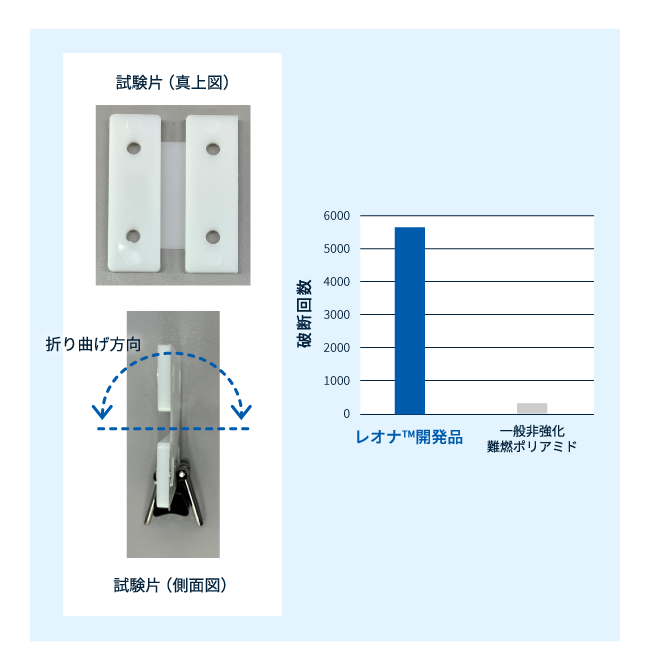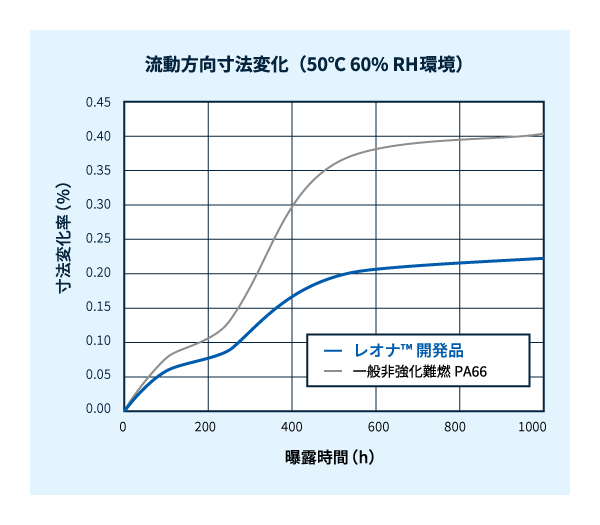インタビュー

2025.07.04

技術・製品紹介
旭化成は、バイオマスポリアミドと特殊ポリアミドを独自のコンパウンド技術で混錬することにより 、低吸水・高靭性・PFASフリーの難燃ポリアミドを開発しました。
現在ガラス繊維などの無機物を含有しない非強化系難燃樹脂は、コネクタやクランプなどの用途で広く使われていますが、この非強化難燃樹脂には難燃性を確保するために添加剤が多くなり、靭性が低下するという課題があります。また難燃助剤として使用されるフッ素樹脂は環境規制の対象となりつつあるPFASに分類されるため、今後の使用に制限がかかる可能性があります。
当社が開発したレオナ™PFASフリー低吸水・高靭性難燃ポリアミド(開発品)は高機能と環境規制対応を両立した次世代の非強化難燃ポリアミドとして幅広い用途に貢献できます。
レオナ™PFASフリー低吸水・高靭性難燃ポリアミド(開発品)の特長は以下の通りです。
非強化系難燃樹脂は難燃性特性を付与するために難燃剤量が多くなり、靭性が低下する傾向にあります。このように靭性が低下すると、コネクタやクランプで多用されるスナップフィット※による固定やヒンジのような組立時に変形する部位を持つ製品では、変形に耐えられず割れてしまうことがあります。
※スナップフィットとは、金属やプラスチックなどの結合に用いられる機械的接合法の一種で、材料の弾性を利用してはめ込むことにより固定する方式のこと。
 スナップフィット図例
スナップフィット図例
当社開発品は優れた靭性を有しており、動画のように折り曲げを繰り返す評価では一般非強化難燃ポリアミドの10倍以上の耐久性があることが確認されました。
 ヒンジ試験評価結果
ヒンジ試験評価結果
一般的なポリアミドは大気中の水分を徐々に吸水することで製品寸法が変化します。海運時など高温多湿な環境では吸水量が増加に伴い、寸法もより大きく変化するため、組立時に不良が発生しやすくなります。このため吸水による寸法変化を抑制するためにポリブチレンテレフタレート(PBT)が選択されることがありますが、PBTはポリアミドより靭性が低く、組立時に割れやすいという課題があります。またPBTは高温多湿な環境において加水分解が発生しやすく、ポリアミドよりも強度低下が大きくなります。
当社開発品の吸水特性は一般非強化難燃ポリアミドの約半分であり、さらにPBTよりも靭性と耐加水分解性に優れています。これらの特長から、これまでポリアミドやPBTの使用が難しかった高い寸法精度を必要とする部品へ適用できる可能性があると考えます。
下図は赤道付近の海運時を想定した環境での吸水と寸法変化の評価結果です。また、これよりもより厳しい85℃/85%RH環境下でも一般ポリアミドより優れていることを確認しています。
For detailed data, please contact us via the form below.
 高温多湿環境下での寸法安定性比較
高温多湿環境下での寸法安定性比較
詳細なデータをご希望の方は下記フォームよりお問合せ願います。